

7. Search Strategies. (This is originally a chapter from the book Efficient information searching on the web.)
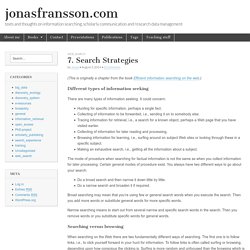
Different types of information seeking There are many types of information seeking. It could concern: Hunting for specific information, perhaps a single fact.Collecting of information to be forwarded, i.e., sending it on to somebody else.Tracing information for retrieval, i.e., a search for a known object, perhaps a Web page that you have visited earlier.Collecting of information for later reading and processing.Browsing information for learning, i.e., surfing around on subject Web sites or looking through these in a specific subject.Making an exhaustive search, i.e., getting all the information about a subject.
The mode of procedure when searching for factual information is not the same as when you collect information for later processing. TOP TEN DATABASE SEARCH TIPS – Library. 1.
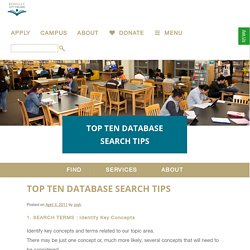
SEARCH TERMS : Identify Key Concepts Identify key concepts and terms related to our topic area. There may be just one concept or, much more likely, several concepts that will need to be considered. Within each concept, you will need to determine appropriate words or phrases, including synonyms, broader terms, related terms and narrower terms. Revise this list during the actual search process by noting and using subject headings that have been assigned to relevant books and articles. Broadly speaking you can search three distinct places: library catalogs (for books), databases (for articles) and the freely available Internet (for rare needles in the haystack). Books, searchable via library catalogs, are great sources of both general and highly specific information. 15 second search tips. Cambridge University Press 2009. From the book Search User Interfaces, published by Cambridge University Press.
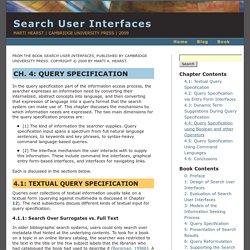
Copyright © 2009 by Marti A. Hearst. In the query specification part of the information access process, the searcher expresses an information need by converting their internalized, abstract concepts into language, and then converting that expression of language into a query format that the search system can make use of. This chapter discusses the mechanisms by which information needs are expressed. The two main dimensions for the query specification process are: [1] The kind of information the searcher supplies.
Each is discussed in the sections below. 4.1: Textual Query Specification Queries over collections of textual information usually take on a textual form (querying against multimedia is discussed in Chapter 12).
Refine web searches - Google Search Help. How to use search like a pro: 10 tips and tricks for Google and beyond. Search engines are pretty good at finding what you’re looking for these days, but sometimes they still come up short.
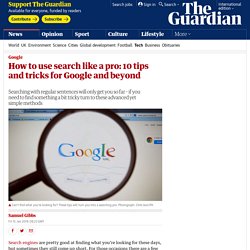
For those occasions there are a few little known tricks which come in handy. So here are some tips for better googling (as it’s the most popular search engine) but many will work on other search engines too. 1. Exact phrase The simplest and most effective way to search for something specific is to use quote marks around a phrase or name to search for those exact words in that exact order. For instance, searching for Joe Bloggs will show results with both Joe and Bloggs but not necessarily placed sequentially.
The exact or explicit phrase search is very useful for excluding more common but less relevant results. 2. If exact phrase doesn’t get you what you need, you can specifically exclude certain words using the minus symbol. Literature searching explained.
Narrowing Google Searches. YouTube. YouTube. YouTube. Filter and refine your Google Search results. Time. Plan: Developing Research Strategies. Scenario Sarah’s art history professor just assigned the course project and Sarah is delighted that it isn’t the typical research paper.
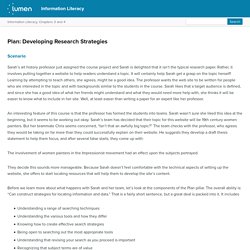
Rather, it involves putting together a website to help readers understand a topic. It will certainly help Sarah get a grasp on the topic herself! Learning by attempting to teach others, she agrees, might be a good idea. The professor wants the web site to be written for people who are interested in the topic and with backgrounds similar to the students in the course. An interesting feature of this course is that the professor has formed the students into teams. The involvement of women painters in the Impressionist movement had an effect upon the subjects portrayed. They decide this sounds more manageable. Before we learn more about what happens with Sarah and her team, let’s look at the components of the Plan pillar.
And these are just the items to understand! Here is a visual representation of these components: Proficiencies in the Plan pillar educat* Web search query. Query that user enters into a web search engine Types[edit] There are three broad categories that cover most web search queries: informational, navigational, and transactional.[1] These are also called "do, know, go.
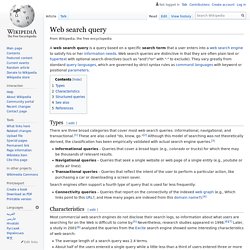
"[2] Although this model of searching was not theoretically derived, the classification has been empirically validated with actual search engine queries.[3] Informational queries – Queries that cover a broad topic (e.g., colorado or trucks) for which there may be thousands of relevant results.Navigational queries – Queries that seek a single website or web page of a single entity (e.g., youtube or delta air lines).Transactional queries – Queries that reflect the intent of the user to perform a particular action, like purchasing a car or downloading a screen saver.